Earthwork Estimating: Cut and Fill Volume Calculation
VerifiedAdded on 2023/06/03
|6
|1027
|366
Practical Assignment
AI Summary
This assignment focuses on earthwork estimating, a crucial process in construction projects, using the 4-corner method to calculate cut and fill volumes. The solution involves dividing the site into grids, determining elevation differences at each corner, and calculating average cut or fill depths. The document details the calculations for four grids, considering a mandatory 250 mm topsoil excavation. The provided solution calculates elevation differences, averages fill depths, and determines cut and fill volumes for each grid. It also includes a table summarizing the total cut and fill volumes, emphasizing the importance of these calculations for resource allocation and cost reduction in construction. References include MES Innovation and The University of Georgia.
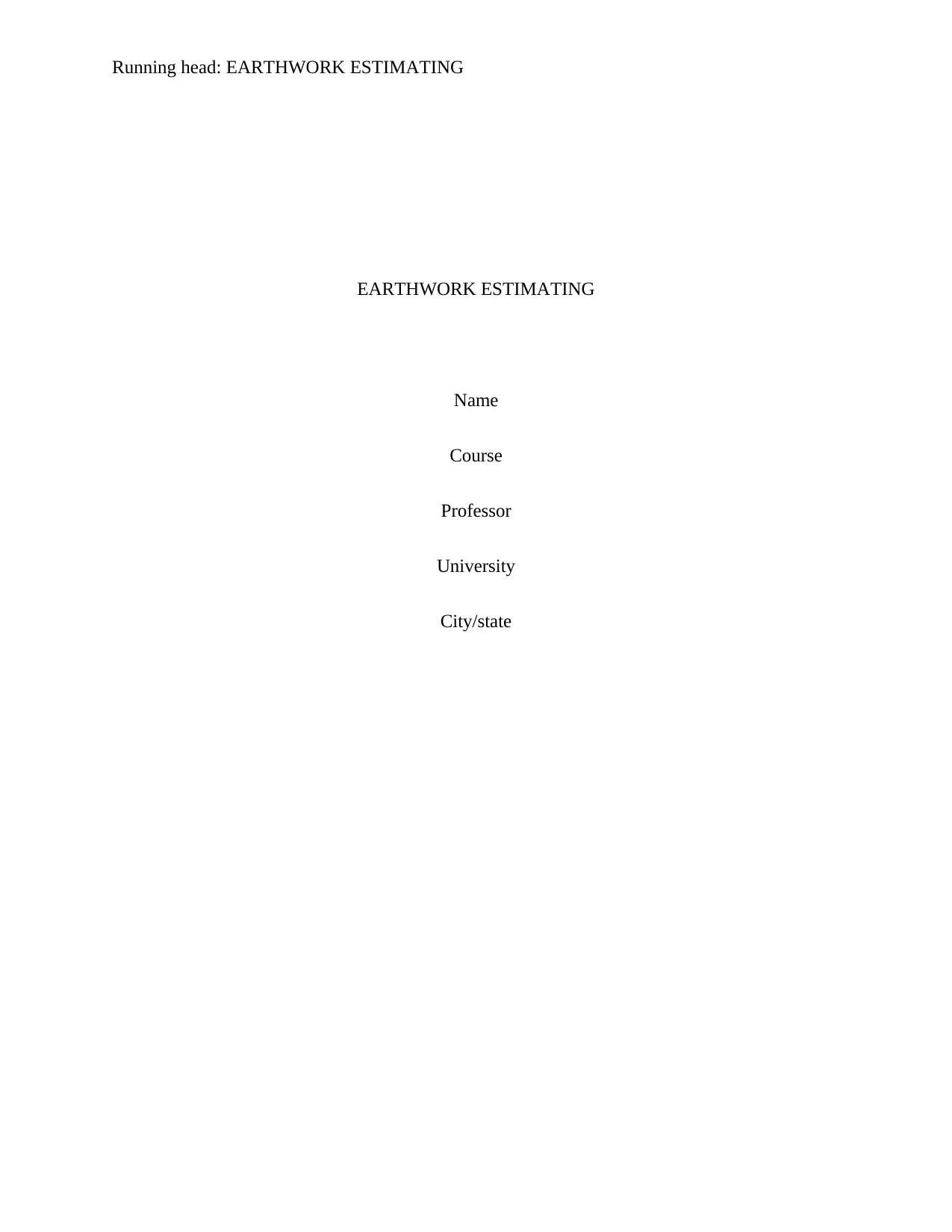
Running head: EARTHWORK ESTIMATING
EARTHWORK ESTIMATING
Name
Course
Professor
University
City/state
EARTHWORK ESTIMATING
Name
Course
Professor
University
City/state
Paraphrase This Document
Need a fresh take? Get an instant paraphrase of this document with our AI Paraphraser
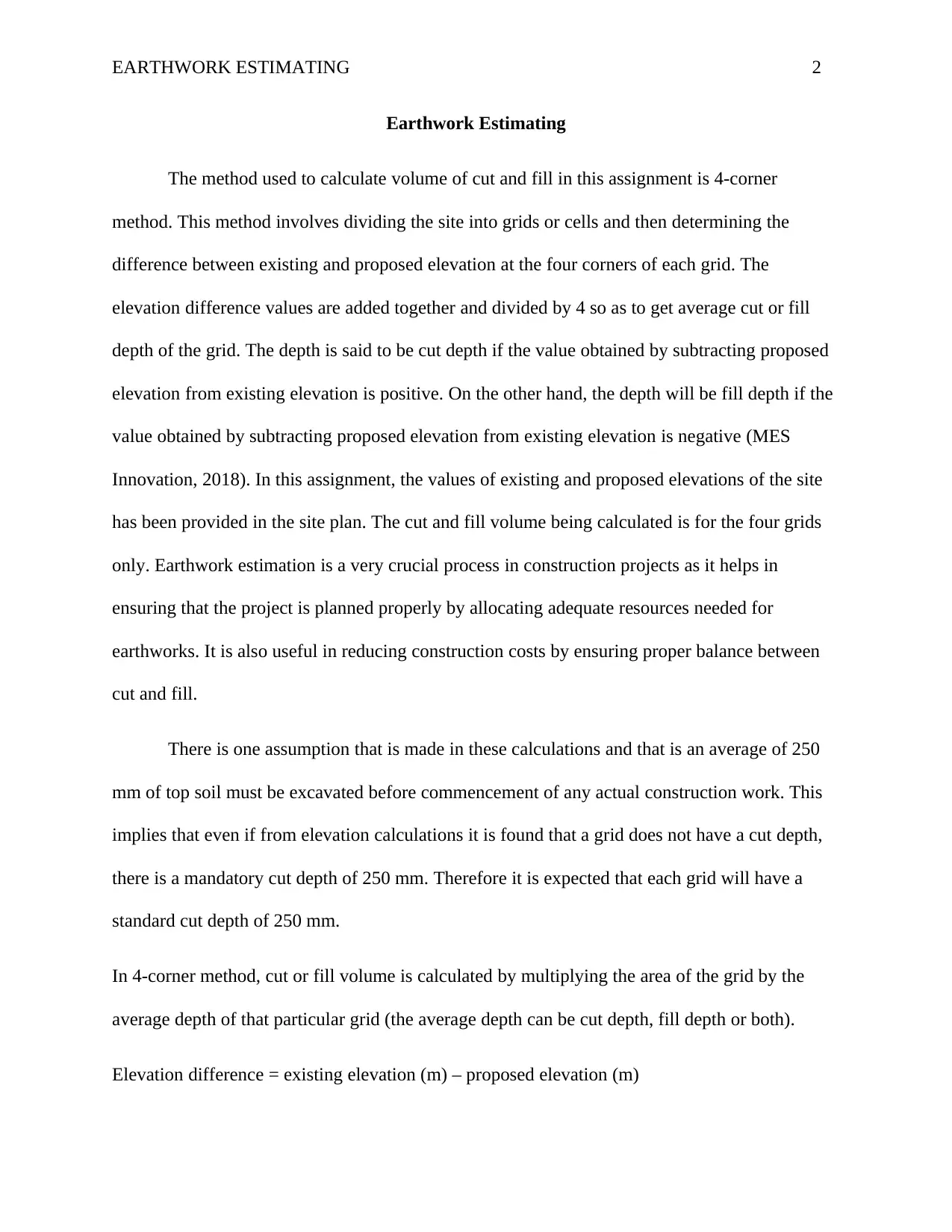
EARTHWORK ESTIMATING 2
Earthwork Estimating
The method used to calculate volume of cut and fill in this assignment is 4-corner
method. This method involves dividing the site into grids or cells and then determining the
difference between existing and proposed elevation at the four corners of each grid. The
elevation difference values are added together and divided by 4 so as to get average cut or fill
depth of the grid. The depth is said to be cut depth if the value obtained by subtracting proposed
elevation from existing elevation is positive. On the other hand, the depth will be fill depth if the
value obtained by subtracting proposed elevation from existing elevation is negative (MES
Innovation, 2018). In this assignment, the values of existing and proposed elevations of the site
has been provided in the site plan. The cut and fill volume being calculated is for the four grids
only. Earthwork estimation is a very crucial process in construction projects as it helps in
ensuring that the project is planned properly by allocating adequate resources needed for
earthworks. It is also useful in reducing construction costs by ensuring proper balance between
cut and fill.
There is one assumption that is made in these calculations and that is an average of 250
mm of top soil must be excavated before commencement of any actual construction work. This
implies that even if from elevation calculations it is found that a grid does not have a cut depth,
there is a mandatory cut depth of 250 mm. Therefore it is expected that each grid will have a
standard cut depth of 250 mm.
In 4-corner method, cut or fill volume is calculated by multiplying the area of the grid by the
average depth of that particular grid (the average depth can be cut depth, fill depth or both).
Elevation difference = existing elevation (m) – proposed elevation (m)
Earthwork Estimating
The method used to calculate volume of cut and fill in this assignment is 4-corner
method. This method involves dividing the site into grids or cells and then determining the
difference between existing and proposed elevation at the four corners of each grid. The
elevation difference values are added together and divided by 4 so as to get average cut or fill
depth of the grid. The depth is said to be cut depth if the value obtained by subtracting proposed
elevation from existing elevation is positive. On the other hand, the depth will be fill depth if the
value obtained by subtracting proposed elevation from existing elevation is negative (MES
Innovation, 2018). In this assignment, the values of existing and proposed elevations of the site
has been provided in the site plan. The cut and fill volume being calculated is for the four grids
only. Earthwork estimation is a very crucial process in construction projects as it helps in
ensuring that the project is planned properly by allocating adequate resources needed for
earthworks. It is also useful in reducing construction costs by ensuring proper balance between
cut and fill.
There is one assumption that is made in these calculations and that is an average of 250
mm of top soil must be excavated before commencement of any actual construction work. This
implies that even if from elevation calculations it is found that a grid does not have a cut depth,
there is a mandatory cut depth of 250 mm. Therefore it is expected that each grid will have a
standard cut depth of 250 mm.
In 4-corner method, cut or fill volume is calculated by multiplying the area of the grid by the
average depth of that particular grid (the average depth can be cut depth, fill depth or both).
Elevation difference = existing elevation (m) – proposed elevation (m)
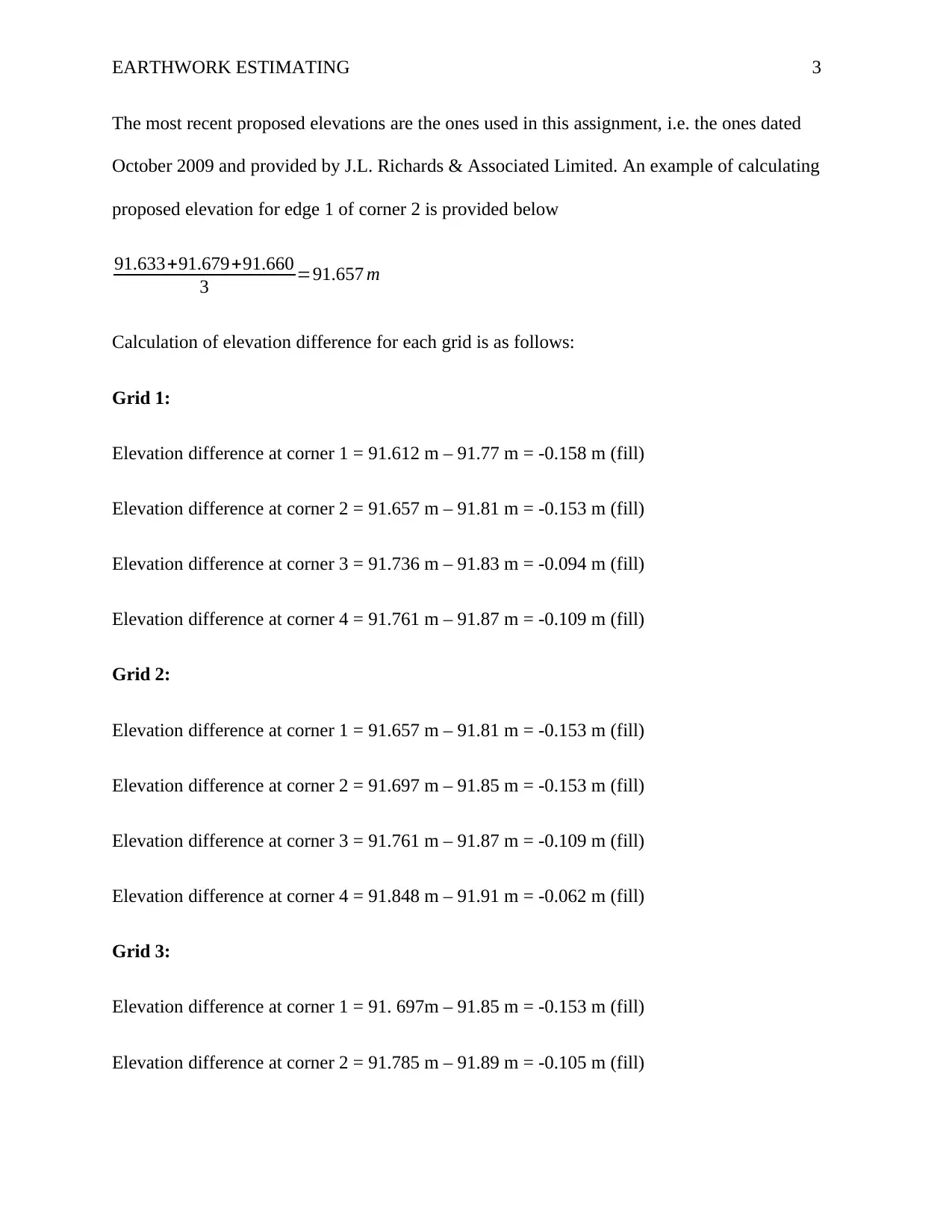
EARTHWORK ESTIMATING 3
The most recent proposed elevations are the ones used in this assignment, i.e. the ones dated
October 2009 and provided by J.L. Richards & Associated Limited. An example of calculating
proposed elevation for edge 1 of corner 2 is provided below
91.633+91.679+91.660
3 =91.657 m
Calculation of elevation difference for each grid is as follows:
Grid 1:
Elevation difference at corner 1 = 91.612 m – 91.77 m = -0.158 m (fill)
Elevation difference at corner 2 = 91.657 m – 91.81 m = -0.153 m (fill)
Elevation difference at corner 3 = 91.736 m – 91.83 m = -0.094 m (fill)
Elevation difference at corner 4 = 91.761 m – 91.87 m = -0.109 m (fill)
Grid 2:
Elevation difference at corner 1 = 91.657 m – 91.81 m = -0.153 m (fill)
Elevation difference at corner 2 = 91.697 m – 91.85 m = -0.153 m (fill)
Elevation difference at corner 3 = 91.761 m – 91.87 m = -0.109 m (fill)
Elevation difference at corner 4 = 91.848 m – 91.91 m = -0.062 m (fill)
Grid 3:
Elevation difference at corner 1 = 91. 697m – 91.85 m = -0.153 m (fill)
Elevation difference at corner 2 = 91.785 m – 91.89 m = -0.105 m (fill)
The most recent proposed elevations are the ones used in this assignment, i.e. the ones dated
October 2009 and provided by J.L. Richards & Associated Limited. An example of calculating
proposed elevation for edge 1 of corner 2 is provided below
91.633+91.679+91.660
3 =91.657 m
Calculation of elevation difference for each grid is as follows:
Grid 1:
Elevation difference at corner 1 = 91.612 m – 91.77 m = -0.158 m (fill)
Elevation difference at corner 2 = 91.657 m – 91.81 m = -0.153 m (fill)
Elevation difference at corner 3 = 91.736 m – 91.83 m = -0.094 m (fill)
Elevation difference at corner 4 = 91.761 m – 91.87 m = -0.109 m (fill)
Grid 2:
Elevation difference at corner 1 = 91.657 m – 91.81 m = -0.153 m (fill)
Elevation difference at corner 2 = 91.697 m – 91.85 m = -0.153 m (fill)
Elevation difference at corner 3 = 91.761 m – 91.87 m = -0.109 m (fill)
Elevation difference at corner 4 = 91.848 m – 91.91 m = -0.062 m (fill)
Grid 3:
Elevation difference at corner 1 = 91. 697m – 91.85 m = -0.153 m (fill)
Elevation difference at corner 2 = 91.785 m – 91.89 m = -0.105 m (fill)
⊘ This is a preview!⊘
Do you want full access?
Subscribe today to unlock all pages.

Trusted by 1+ million students worldwide
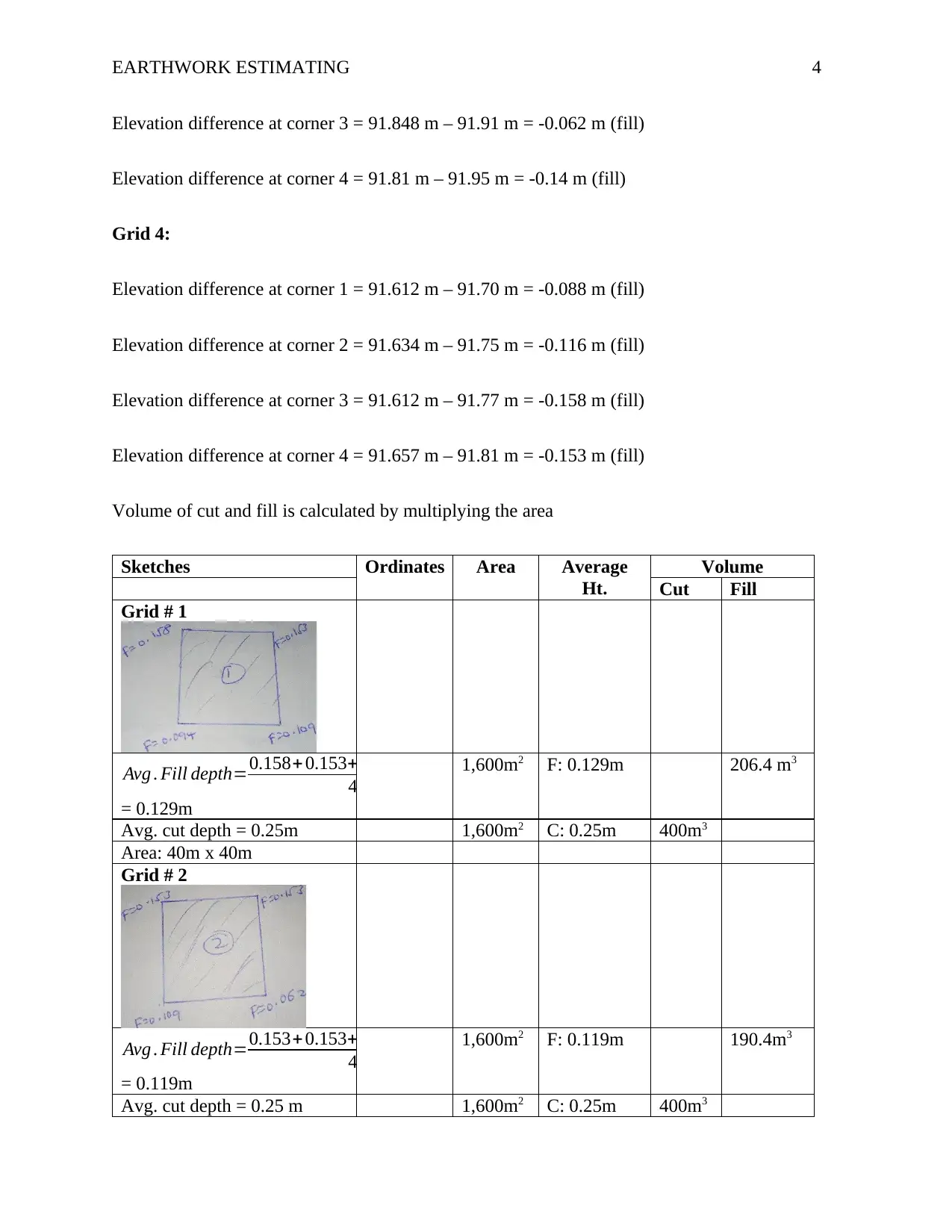
EARTHWORK ESTIMATING 4
Elevation difference at corner 3 = 91.848 m – 91.91 m = -0.062 m (fill)
Elevation difference at corner 4 = 91.81 m – 91.95 m = -0.14 m (fill)
Grid 4:
Elevation difference at corner 1 = 91.612 m – 91.70 m = -0.088 m (fill)
Elevation difference at corner 2 = 91.634 m – 91.75 m = -0.116 m (fill)
Elevation difference at corner 3 = 91.612 m – 91.77 m = -0.158 m (fill)
Elevation difference at corner 4 = 91.657 m – 91.81 m = -0.153 m (fill)
Volume of cut and fill is calculated by multiplying the area
Sketches Ordinates Area Average
Ht.
Volume
Cut Fill
Grid # 1
Avg . Fill depth=0.158+ 0.153+0.094+0.109
4
= 0.129m
1,600m2 F: 0.129m 206.4 m3
Avg. cut depth = 0.25m 1,600m2 C: 0.25m 400m3
Area: 40m x 40m
Grid # 2
Avg . Fill depth=0.153+0.153+ 0.109+0.062
4
= 0.119m
1,600m2 F: 0.119m 190.4m3
Avg. cut depth = 0.25 m 1,600m2 C: 0.25m 400m3
Elevation difference at corner 3 = 91.848 m – 91.91 m = -0.062 m (fill)
Elevation difference at corner 4 = 91.81 m – 91.95 m = -0.14 m (fill)
Grid 4:
Elevation difference at corner 1 = 91.612 m – 91.70 m = -0.088 m (fill)
Elevation difference at corner 2 = 91.634 m – 91.75 m = -0.116 m (fill)
Elevation difference at corner 3 = 91.612 m – 91.77 m = -0.158 m (fill)
Elevation difference at corner 4 = 91.657 m – 91.81 m = -0.153 m (fill)
Volume of cut and fill is calculated by multiplying the area
Sketches Ordinates Area Average
Ht.
Volume
Cut Fill
Grid # 1
Avg . Fill depth=0.158+ 0.153+0.094+0.109
4
= 0.129m
1,600m2 F: 0.129m 206.4 m3
Avg. cut depth = 0.25m 1,600m2 C: 0.25m 400m3
Area: 40m x 40m
Grid # 2
Avg . Fill depth=0.153+0.153+ 0.109+0.062
4
= 0.119m
1,600m2 F: 0.119m 190.4m3
Avg. cut depth = 0.25 m 1,600m2 C: 0.25m 400m3
Paraphrase This Document
Need a fresh take? Get an instant paraphrase of this document with our AI Paraphraser
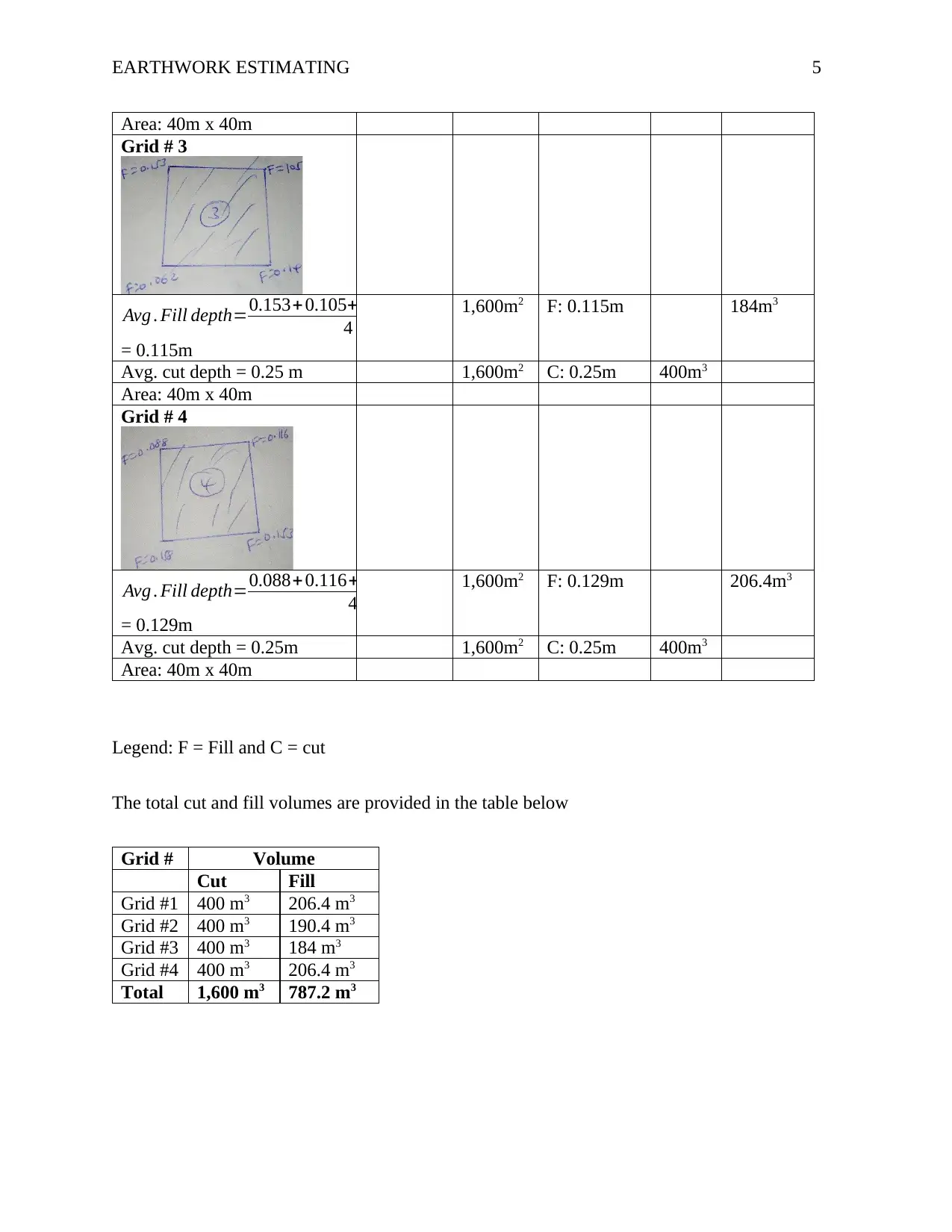
EARTHWORK ESTIMATING 5
Area: 40m x 40m
Grid # 3
Avg . Fill depth=0.153+0.105+ 0.062+0.14
4
= 0.115m
1,600m2 F: 0.115m 184m3
Avg. cut depth = 0.25 m 1,600m2 C: 0.25m 400m3
Area: 40m x 40m
Grid # 4
Avg . Fill depth=0.088+0.116+0.158+0.153
4
= 0.129m
1,600m2 F: 0.129m 206.4m3
Avg. cut depth = 0.25m 1,600m2 C: 0.25m 400m3
Area: 40m x 40m
Legend: F = Fill and C = cut
The total cut and fill volumes are provided in the table below
Grid # Volume
Cut Fill
Grid #1 400 m3 206.4 m3
Grid #2 400 m3 190.4 m3
Grid #3 400 m3 184 m3
Grid #4 400 m3 206.4 m3
Total 1,600 m3 787.2 m3
Area: 40m x 40m
Grid # 3
Avg . Fill depth=0.153+0.105+ 0.062+0.14
4
= 0.115m
1,600m2 F: 0.115m 184m3
Avg. cut depth = 0.25 m 1,600m2 C: 0.25m 400m3
Area: 40m x 40m
Grid # 4
Avg . Fill depth=0.088+0.116+0.158+0.153
4
= 0.129m
1,600m2 F: 0.129m 206.4m3
Avg. cut depth = 0.25m 1,600m2 C: 0.25m 400m3
Area: 40m x 40m
Legend: F = Fill and C = cut
The total cut and fill volumes are provided in the table below
Grid # Volume
Cut Fill
Grid #1 400 m3 206.4 m3
Grid #2 400 m3 190.4 m3
Grid #3 400 m3 184 m3
Grid #4 400 m3 206.4 m3
Total 1,600 m3 787.2 m3
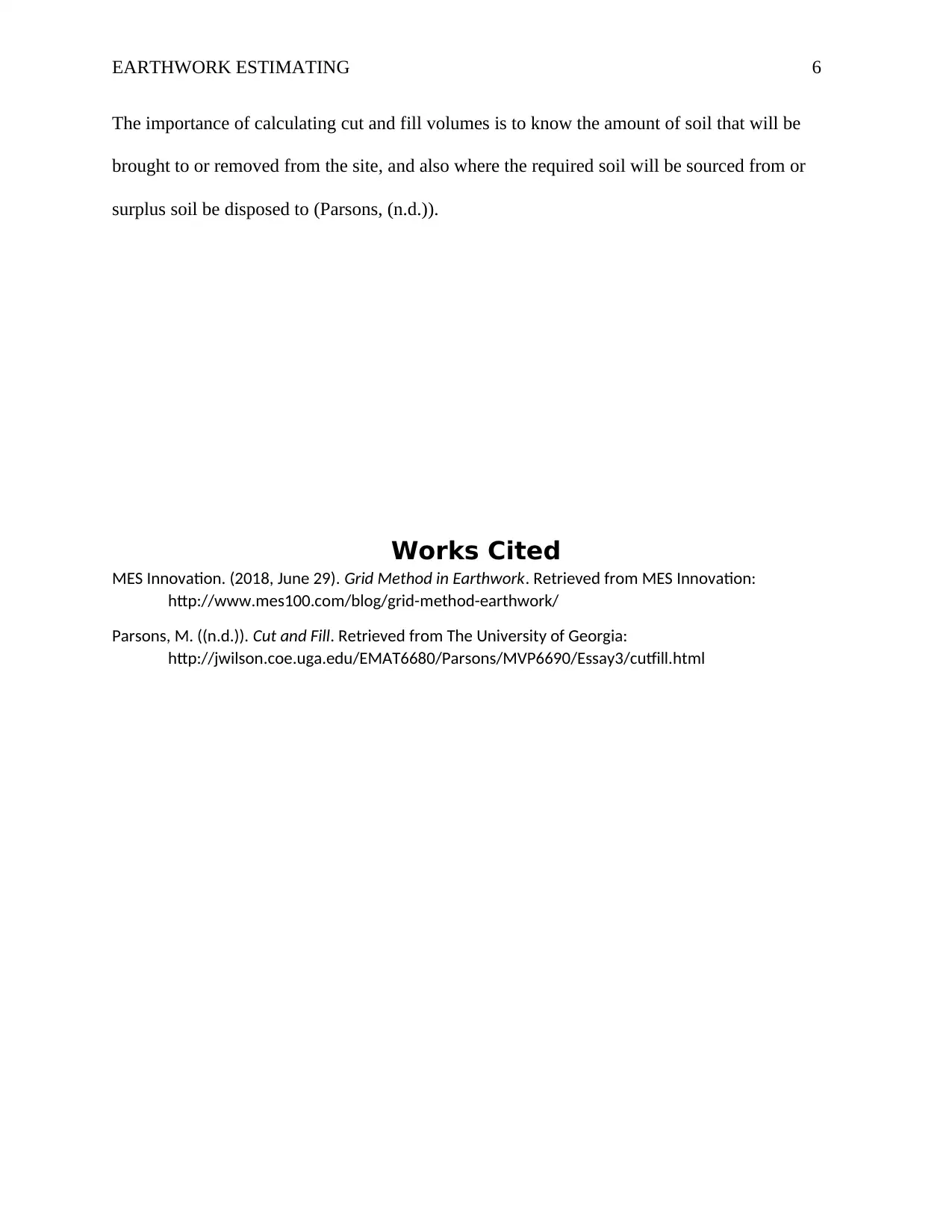
EARTHWORK ESTIMATING 6
The importance of calculating cut and fill volumes is to know the amount of soil that will be
brought to or removed from the site, and also where the required soil will be sourced from or
surplus soil be disposed to (Parsons, (n.d.)).
Works Cited
MES Innovation. (2018, June 29). Grid Method in Earthwork. Retrieved from MES Innovation:
http://www.mes100.com/blog/grid-method-earthwork/
Parsons, M. ((n.d.)). Cut and Fill. Retrieved from The University of Georgia:
http://jwilson.coe.uga.edu/EMAT6680/Parsons/MVP6690/Essay3/cutfill.html
The importance of calculating cut and fill volumes is to know the amount of soil that will be
brought to or removed from the site, and also where the required soil will be sourced from or
surplus soil be disposed to (Parsons, (n.d.)).
Works Cited
MES Innovation. (2018, June 29). Grid Method in Earthwork. Retrieved from MES Innovation:
http://www.mes100.com/blog/grid-method-earthwork/
Parsons, M. ((n.d.)). Cut and Fill. Retrieved from The University of Georgia:
http://jwilson.coe.uga.edu/EMAT6680/Parsons/MVP6690/Essay3/cutfill.html
⊘ This is a preview!⊘
Do you want full access?
Subscribe today to unlock all pages.

Trusted by 1+ million students worldwide
1 out of 6
Related Documents
Your All-in-One AI-Powered Toolkit for Academic Success.
+13062052269
info@desklib.com
Available 24*7 on WhatsApp / Email
![[object Object]](/_next/static/media/star-bottom.7253800d.svg)
Unlock your academic potential
Copyright © 2020–2025 A2Z Services. All Rights Reserved. Developed and managed by ZUCOL.




